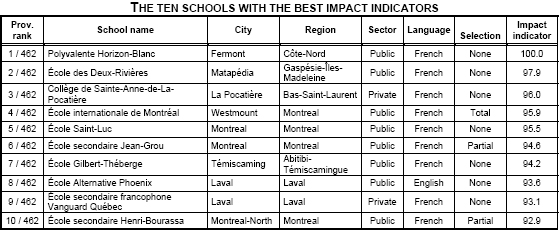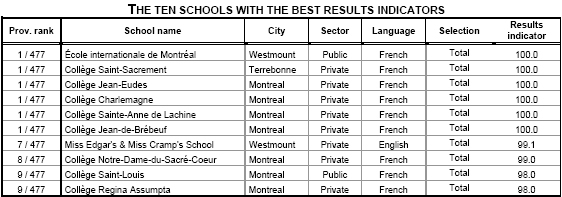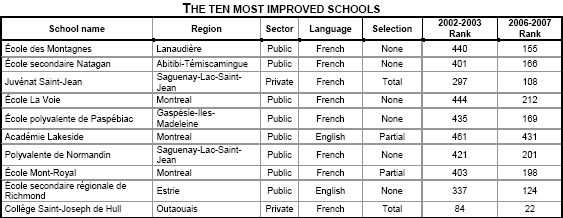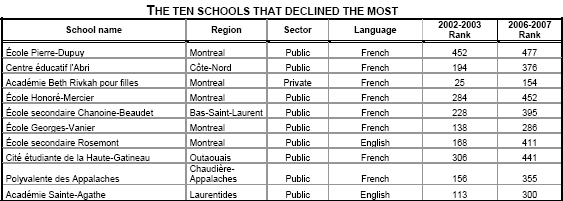A Ranking of High Schools that gives a fair picture

Montreal, October 23, 2008 – For the first time, the 2008 Ranking of Quebec High Schools (Palmarès des écoles secondaires du Québec 2008), prepared by the Montreal Economic Institute (MEI) and published by L’actualité magazine, evaluates the impact of the schools themselves on academic performance, having accounted for student selection and the importance of social environment. This new indicator is an indispensable tool for parents and teachers who want a fair picture of each school’s contribution to its students’ success. One of the study’s two authors, Marcel Boyer, MEI vice president and chief economist, explains that “we are turning a new page: parents now have a reliable and accessible comparison tool for choosing or questioning their school, and those within the educational system will appreciate the fact that the efforts of institutions that do not select their students – and often work within a difficult environment – are recognized.” Many public schools make a good showing, filling eight of the top ten spots for school impact and eight of the top ten for improvement rate over the last five years.
The new impact indicator reveals a school’s contribution to success
The impact indicator is a new tool for parents to use in determining the contribution of a school’s team of teachers, professionals, and administrators to the success of their students. This indicator must be used in conjunction with the general ranking in order to arrive at a fair judgment of those schools that do not use selection. Currently, a large majority of private institutions and half of public high schools select all or some of their students. According to Mathieu Laberge, MEI economist and coauthor of the Ranking, “Contrary to popular opinion, it is not the private or public character of an institution that gives it an advantage in the academic results ranking, but rather this practice of selection, whether it takes place in the private or the public sphere.” Moreover, the impact indicator takes into account the advantage a student gains from his home environment, whether or not the school has a positive influence. The results are thus adjusted according to students’ mothers’ education level and of total household revenue, two predictors of success recognized in the scientific literature.
The results indicator presents a complete and reliable ranking
The results indicator, based on the Department of Education’s provincial exams, and adjusted according to the schools’ promotion and success rates, measures student performance for 478 Quebec high schools. This general ranking is more reliable and rigorous than before due to the addition of confidence intervals that were measured in order to group together schools with results that did not differ by statistically significant amounts. It was recalculated for the last five years. Furthermore, all of the schools that do not figure in the ranking are listed on the website with explanations, making this the most transparent and complete ranking available; in total, 632 schools are included in the database. Participation in the Fédération québécoise du sport étudiant’s ISO-ACTIF healthy habits program is indicated for each school.
A more accessible Ranking
For the first time, graphs allow the reader to see clearly how the two indicators (impact and results) progressed over the last five years. The more user-friendly website is bilingual: www.lactualite-iedm.com/en/. It allows for comparison, at a glance, of a given school with any other schools, as measured by impact, results, promotion rate, as well as average marks and failure rates in core subjects.
The following table shows that the schools that greatly contribute to their students’ advancement are distributed across six regions in Quebec, and are not found only in well-to-do neighbourhoods. Moreover, seven of the ten schools with the highest impact indicators, including the top three, do not select their students.

The following table paints a very different picture than the preceding one, for the schools that top the results ranking practice selection and are located mostly in privileged areas.

The two tables below show changes in school performance over the last five years. Note that among the ten most improved schools, six do not practice selection, and also that half of the ten schools that declined the most are located in Montreal.


The 2008 Portrait of Quebec High Schools was prepared by Marcel Boyer, MEI vice president and chief economist, and Mathieu Laberge, MEI economist. Claude Montmarquette (Université de Montréal) and Clément Lemelin (UQAM) also collaborated on the project. (Authors’ photo)
– 30 –
Information and interview requests: André Valiquette, Director of Communications, Montreal Economic Institute, Tel.: (514) 273-0969 ext. 2225 / Cell: (514) 574-0969 / Email: avaliquette (@iedm.org)

